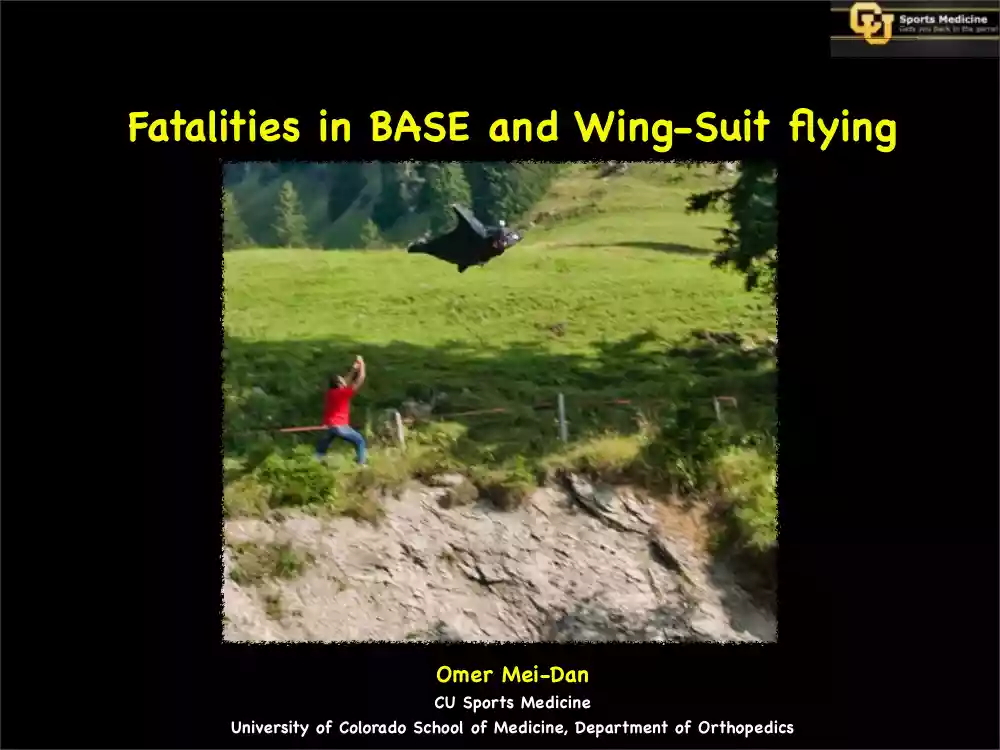Datasheet
Year, pagecount:2014, 31 page(s)
Language:English
Downloads:2
Uploaded:February 14, 2019
Size:9 MB
Institution:
-
Comments:
Attachment:-
Download in PDF:Please log in!
Comments
No comments yet. You can be the first!Most popular documents in this category
Content extract
Source: http://www.doksinet Fatalities in BASE and Wing-Suit flying Omer Mei-Dan CU Sports Medicine University of Colorado School of Medicine, Department of Orthopedics Source: http://www.doksinet “BASE fatality list” The relatively small number of BASE jumpers worldwide and their streamline communication enabled the precise documentation of fatality data. Since 1985, BASE jump fatalities are documented and updated regularly as an open source containing reports on the attributable factors leading to the incident described for the benefit of future participants Source: http://www.doksinet Hitting the walls when jumping in proximity to surrounding objects or when canopy is opened facing the object jumped from No airflow to stabilize body position Less aerodynamic control Source: http://www.doksinet Aerobatics Lack of control / vertigo / too slow-> hitting ground prior to deployment Loss of body position -> chute is not deployed in box position Source:
http://www.doksinet Calculation of the approximate overall BASE jumping annual fatality risk during the year 2002 was of one fatality per 60 participants per year The fatality rate associated with skydiving from 1994 to 2009 has gradually increased, from 0.008 to 001 per 4,000 solo jumpers per year As so, the overall annual fatality risk in BASE jumping is approximately 40–65 times higher than in skydiving Source: http://www.doksinet We are in 2014 and the current number is 230: 25 years - 106 8 years - 124 Source: http://www.doksinet Since 1981 to date, there were 230 BASE jumping documented fatalities a Fatality rates for BASE jumping seem to be consistent, with a moderate increase corresponding with the growth of the sport: 2009 - 15 2010 - 16 2011 - 20 2012 - 19 2013 - 24 Source: http://www.doksinet The Epidemiology of Severe and Catastrophic Injuries in BASE Jumping Omer Mei-Dan, Michael R. Carmont, Erik Monasterio Clinical Journal of Sports Medicine, 2012 72% of
the jumpers had witnessed death or serious injury of other participants in the sport 43% jumpers had suffered significant injury 76% had at least one “near miss” incident Source: http://www.doksinet Can a human being fly ? Source: http://www.doksinet Source: http://www.doksinet Source: http://www.doksinet Source: http://www.doksinet Source: http://www.doksinet Source: http://www.doksinet 15 Source: http://www.doksinet Source: http://www.doksinet 17 Source: http://www.doksinet 2002 to 2007: 61 BASE jumping deaths, 10 (16%) - wing suit related 2008 to 2011: 59 fatal events, 29 (49%) - wing suit related 2013: 21 of 24 (87%) fatalities were wing suit related Source: http://www.doksinet Source: http://www.doksinet Source: http://www.doksinet Source: http://www.doksinet 2013: 19/24 (80%) fatalities occurred between April and October Source: http://www.doksinet Fatalities by country of incident, categorized as related to the use of wing suits or not
related to the use of wing suits The countries from which most wingsuit BASE jumping fatalities were reported: Switzerland (13), Norway (7), and France (8) -> Europe 82% Source: http://www.doksinet Source: http://www.doksinet Source: http://www.doksinet 26 Source: http://www.doksinet Source: http://www.doksinet Conclusion Wingsuit-related BASE jump fatalities appear to be increasing as this version of base jumping becomes more popular. Most fatalities are attributed to cliff or ground impact, and most are the result of flight path miscalculation. As with many other extreme sports, limited experience also seems to be a contributing factor to wingsuit fatalities. Source: http://www.doksinet Conclusion The rapid development in wingsuit design, combined with the jumper’s motivation to push the boundaries, may in essence have led some jumpers to act as test pilots of new wingsuit concepts Source: http://www.doksinet So what do we do about it ? Source:
http://www.doksinet So what do we do about it ? - Proximity flying - the “problem” of better glide ratio and experience - Mis calculation - Pilot chute caught in air burbles - Take off aspects (slipping / stability / no air feeling) - Experience (2 of the fatalities - first wingsuit BASE jump)
http://www.doksinet Calculation of the approximate overall BASE jumping annual fatality risk during the year 2002 was of one fatality per 60 participants per year The fatality rate associated with skydiving from 1994 to 2009 has gradually increased, from 0.008 to 001 per 4,000 solo jumpers per year As so, the overall annual fatality risk in BASE jumping is approximately 40–65 times higher than in skydiving Source: http://www.doksinet We are in 2014 and the current number is 230: 25 years - 106 8 years - 124 Source: http://www.doksinet Since 1981 to date, there were 230 BASE jumping documented fatalities a Fatality rates for BASE jumping seem to be consistent, with a moderate increase corresponding with the growth of the sport: 2009 - 15 2010 - 16 2011 - 20 2012 - 19 2013 - 24 Source: http://www.doksinet The Epidemiology of Severe and Catastrophic Injuries in BASE Jumping Omer Mei-Dan, Michael R. Carmont, Erik Monasterio Clinical Journal of Sports Medicine, 2012 72% of
the jumpers had witnessed death or serious injury of other participants in the sport 43% jumpers had suffered significant injury 76% had at least one “near miss” incident Source: http://www.doksinet Can a human being fly ? Source: http://www.doksinet Source: http://www.doksinet Source: http://www.doksinet Source: http://www.doksinet Source: http://www.doksinet Source: http://www.doksinet 15 Source: http://www.doksinet Source: http://www.doksinet 17 Source: http://www.doksinet 2002 to 2007: 61 BASE jumping deaths, 10 (16%) - wing suit related 2008 to 2011: 59 fatal events, 29 (49%) - wing suit related 2013: 21 of 24 (87%) fatalities were wing suit related Source: http://www.doksinet Source: http://www.doksinet Source: http://www.doksinet Source: http://www.doksinet 2013: 19/24 (80%) fatalities occurred between April and October Source: http://www.doksinet Fatalities by country of incident, categorized as related to the use of wing suits or not
related to the use of wing suits The countries from which most wingsuit BASE jumping fatalities were reported: Switzerland (13), Norway (7), and France (8) -> Europe 82% Source: http://www.doksinet Source: http://www.doksinet Source: http://www.doksinet 26 Source: http://www.doksinet Source: http://www.doksinet Conclusion Wingsuit-related BASE jump fatalities appear to be increasing as this version of base jumping becomes more popular. Most fatalities are attributed to cliff or ground impact, and most are the result of flight path miscalculation. As with many other extreme sports, limited experience also seems to be a contributing factor to wingsuit fatalities. Source: http://www.doksinet Conclusion The rapid development in wingsuit design, combined with the jumper’s motivation to push the boundaries, may in essence have led some jumpers to act as test pilots of new wingsuit concepts Source: http://www.doksinet So what do we do about it ? Source:
http://www.doksinet So what do we do about it ? - Proximity flying - the “problem” of better glide ratio and experience - Mis calculation - Pilot chute caught in air burbles - Take off aspects (slipping / stability / no air feeling) - Experience (2 of the fatalities - first wingsuit BASE jump)





 When reading, most of us just let a story wash over us, getting lost in the world of the book rather than paying attention to the individual elements of the plot or writing. However, in English class, our teachers ask us to look at the mechanics of the writing.
When reading, most of us just let a story wash over us, getting lost in the world of the book rather than paying attention to the individual elements of the plot or writing. However, in English class, our teachers ask us to look at the mechanics of the writing.